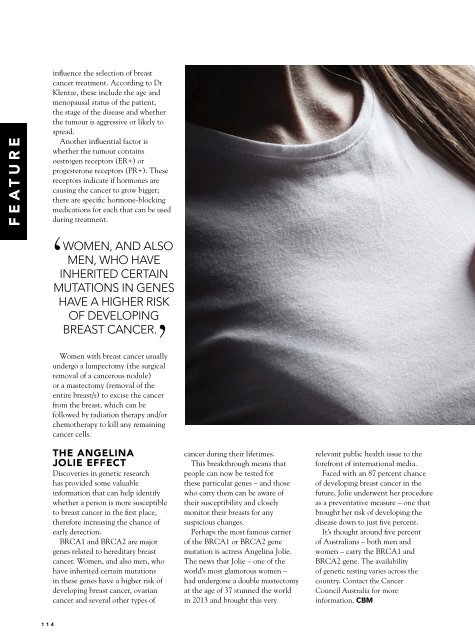CosBeauty Magazine #89
CosBeauty is the #BeautyAddict's guide to lifestyle, health and beauty in Australia. In this issue: - Wanderlust - How to Create the Ultimate Staycation - Ready. Set. Selfie. Cosmetic Surgery in the Instagram Age - 300+ Skincare & Makeup Products You Need now - Why It's Time To Take Stock of Your Skincare Routine - Everything you need to know about Rhinoplasty
CosBeauty is the #BeautyAddict's guide to lifestyle, health and beauty in Australia.
In this issue:
- Wanderlust - How to Create the Ultimate Staycation
- Ready. Set. Selfie. Cosmetic Surgery in the Instagram Age
- 300+ Skincare & Makeup Products You Need now
- Why It's Time To Take Stock of Your Skincare Routine
- Everything you need to know about Rhinoplasty
You also want an ePaper? Increase the reach of your titles
YUMPU automatically turns print PDFs into web optimized ePapers that Google loves.
FEATURE<br />
influence the selection of breast<br />
cancer treatment. According to Dr<br />
Klentze, these include the age and<br />
menopausal status of the patient,<br />
the stage of the disease and whether<br />
the tumour is aggressive or likely to<br />
spread.<br />
Another influential factor is<br />
whether the tumour contains<br />
oestrogen receptors (ER+) or<br />
progesterone receptors (PR+). These<br />
receptors indicate if hormones are<br />
causing the cancer to grow bigger;<br />
there are specific hormone-blocking<br />
medications for each that can be used<br />
during treatment.<br />
WOMEN, AND ALSO<br />
MEN, WHO HAVE<br />
INHERITED CERTAIN<br />
MUTATIONS IN GENES<br />
HAVE A HIGHER RISK<br />
OF DEVELOPING<br />
BREAST CANCER.<br />
Women with breast cancer usually<br />
undergo a lumpectomy (the surgical<br />
removal of a cancerous nodule)<br />
or a mastectomy (removal of the<br />
entire breast/s) to excise the cancer<br />
from the breast, which can be<br />
followed by radiation therapy and/or<br />
chemotherapy to kill any remaining<br />
cancer cells.<br />
THE ANGELINA<br />
JOLIE EFFECT<br />
Discoveries in genetic research<br />
has provided some valuable<br />
information that can help identify<br />
whether a person is more susceptible<br />
to breast cancer in the first place,<br />
therefore increasing the chance of<br />
early detection.<br />
BRCA1 and BRCA2 are major<br />
genes related to hereditary breast<br />
cancer. Women, and also men, who<br />
have inherited certain mutations<br />
in these genes have a higher risk of<br />
developing breast cancer, ovarian<br />
cancer and several other types of<br />
cancer during their lifetimes.<br />
This breakthrough means that<br />
people can now be tested for<br />
these particular genes – and those<br />
who carry them can be aware of<br />
their susceptibility and closely<br />
monitor their breasts for any<br />
suspicious changes.<br />
Perhaps the most famous carrier<br />
of the BRCA1 or BRCA2 gene<br />
mutation is actress Angelina Jolie.<br />
The news that Jolie – one of the<br />
world’s most glamorous women –<br />
had undergone a double mastectomy<br />
at the age of 37 stunned the world<br />
in 2013 and brought this very<br />
relevant public health issue to the<br />
forefront of international media.<br />
Faced with an 87 percent chance<br />
of developing breast cancer in the<br />
future, Jolie underwent her procedure<br />
as a preventative measure – one that<br />
brought her risk of developing the<br />
disease down to just five percent.<br />
It’s thought around five percent<br />
of Australians – both men and<br />
women – carry the BRCA1 and<br />
BRCA2 gene. The availability<br />
of genetic testing varies across the<br />
country. Contact the Cancer<br />
Council Australia for more<br />
information. CBM<br />
114


















